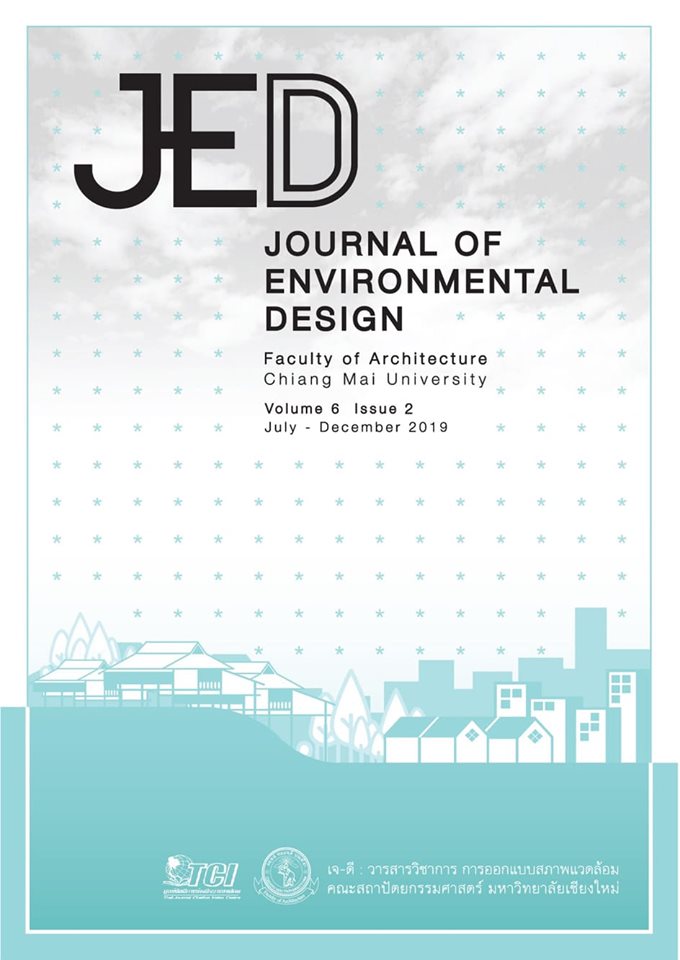การใช้ความรู้เกี่ยวกับสัดส่วนผู้สูงอายุเพื่อเปรียบเทียบความสัมพันธ์ระหว่างเฟอร์นิเจอร์และอุปกรณ์เครื่องใช้ภายในบ้าน: กรณีศึกษา ตำบลแม่กา อำเภอเมือง จังหวัดพะเยา
Main Article Content
บทคัดย่อ
บทความนี้มีวัตถุประสงค์เพื่อเปรียบเทียบความสัมพันธ์ระหว่างสัดส่วนผู้สูงอายุกับเฟอร์นิเจอร์และอุปกรณ์เครื่องใช้ภายในบ้าน มีวิธีการวิจัย และเครื่องมือในการเก็บข้อมูลด้วยการวัดสัดส่วนร่างกายผู้สูงอายุ ตัวอย่างกลุ่มประชากร จำนวน 53 คน และการสำรวจขนาดเฟอร์นิเจอร์และอุปกรณ์เครื่องใช้ภายในบ้าน กรณีศึกษาตำบลแม่กา อำเภอเมือง จังหวัดพะเยา เพื่อนำผลมาเปรียบเทียบ เพื่อออกแบบกราฟิกระหว่างสัดส่วนผู้สูงอายุกับเฟอร์นิเจอร์และอุปกรณ์เครื่องใช้ภายในบ้านสำหรับ 3 ลักษณะท่าทางของผู้สูงอายุ คือ ท่ายืน ท่านั่ง และท่าเดิน ผลการวิจัยพบว่าผู้สูงอายุมีความสูงเฉลี่ย 146.84 เซนติเมตร และสูงจากพื้น-ข้อพับแนวเข่า (ด้านใน) เฉลี่ย 37.93 เซนติเมตร เมื่อเปรียบเทียบความสัมพันธ์ระหว่างสัดส่วนผู้สูงอายุกับเฟอร์นิเจอร์และอุปกรณ์เครื่องใช้ภายในบ้าน พบว่า การออกแบบเฟอร์นิเจอร์และอุปกรณ์เครื่องใช้ภายในบ้านเหมาะสมกับท่ายืนคือ อ่างล้างหน้า, เตาไฟแก๊ส ส่วนท่านั่งไม่เหมาะสมกับโถส้วมแบบนั่งยอง เก้าอี้แบบนั่งยองและตำแหน่งในการติดตั้งราวจับ กรณีท่าเดินไม่เหมาะสมกับราวจับบันไดและขั้นบันได งานวิจัยนี้เสนอแนะให้มีการปรับปรุงหรืองดการใช้เฟอร์นิเจอร์และอุปกรณ์ในบ้านที่เสี่ยงต่อการเกิดอุบัติเหตุสำหรับผู้สูงอายุ โดยเฉพาะอย่างยิ่งการกำหนดสิ่งอำนวยความสะดวกที่มีขนาดเดียวกันทั้งประเทศ จึงไม่เหมาะสมในแต่ละพื้นที่ จึงควรพิจารณาปรับปรุงในการออกกฎกระทรวงฉบับใหม่ ซึ่งจะช่วยให้ผู้สูงอายุได้ใช้งานอย่างเหมาะสมปลอดภัยมากยิ่งขึ้น
Article Details
เอกสารอ้างอิง
Horpibulsuk, S. (2014). Bab ko sang sing amnuai kwam saduak mattrathan samrab phu sung-ayu nai sathanthi satharana changwat. (In Thai) [Standard facility design for elderly in public places in Nakhon Ratchasima]. Nakhon Ratchasima: Suranaree University of Technology.
Jarutach, T., et al. (2005). Sueksa mattrathan khan tam samrab tee phak asai lae saphabwaetlom khong phu sung-ayu. (In Thai) [Minimum standard of housing and environment for the elderly]. (Research report). Bangkok: Thailand Research Fund and Thai Health Promotion Foundation.
Kanchanachitra, C. (2008). Khunnaphab chiwit khon thamngan nai phak utsahakam lae phak borikan. (In Thai) [Quality of life of Thai workers in industrial and service sectors]. Bangkok: Thammada press.
Ministry of Interior. (2005). Ratchakitchanubeksa kot krasuang kamnot sing amnuai kwam saduak nai arkhan samrab phu phikan rue thupponlaphap lae khon chara phoso song ha si paet. (In Thai) [Ministerial Regulation Prescribing accessible facilities for persons with disabilities and the elderly. B.E. 2548]. (2005, 2 July). Royal Thai Government Gazette. Rule Number 122 section number 52 ก. pp.4-19.
Opasanun, P., et al. (2016). Karn phayaban phu sung-ayu nai satawat tee 21. (In Thai) [Gerontological Nursing in the 21st century]. Phayao: University of Phayao.


